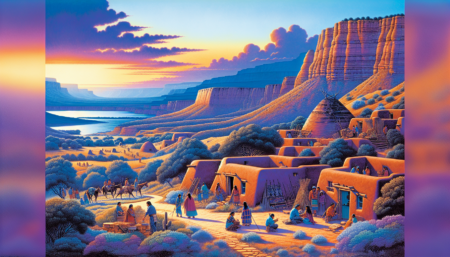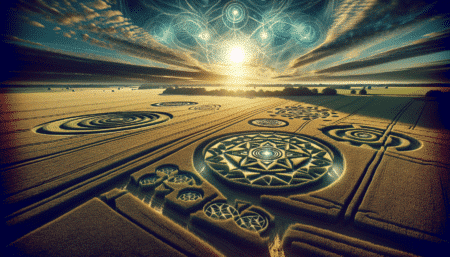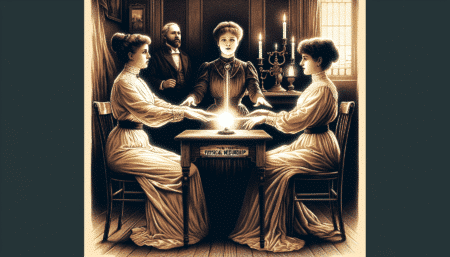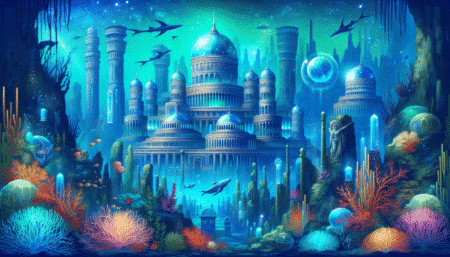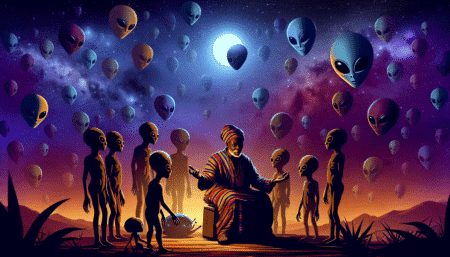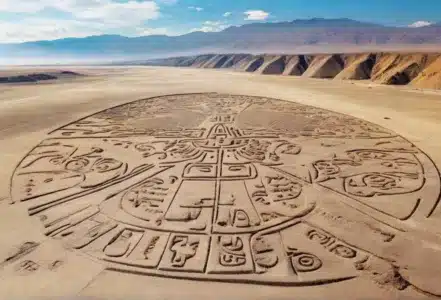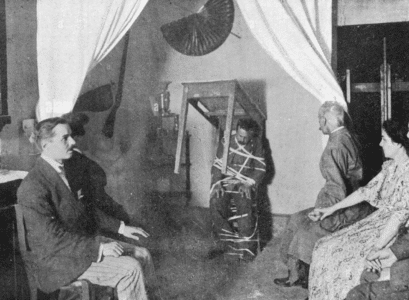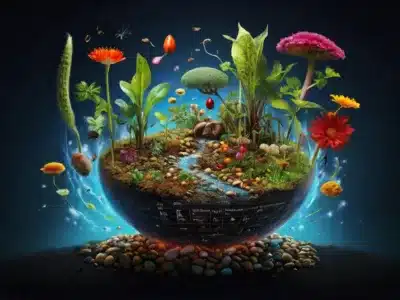- Introduction
- History of the Hopi Indians
- Traditional Hopi way of life
- Spirituality, mental and cultural aspects
- Hopi Indians and aliens
- Wisdom and prophecies of the Hopi Indians
- Summary and outlook
1. introduction
The Hopi Indians are a group of Pueblo peoples living in northeastern Arizona, primarily on the Hopi Tribe of Arizona reservation. With a population of approximately 19,338 in 2010 and a land area of 6,557.26 square kilometers, they embody a significant cultural and historical presence in this region [1]. The Hopi are known for their deep connection to the land, which they consider sacred, and their organized, matrilineal clan structure, as well as their unique culture and traditions such as the Kachina dolls [1] [5].
In this article, we will examine the history of the Hopi Indians, their traditional way of life and their spiritual and cultural aspects in detail. In addition, we will take a look at the connection between the Hopi Indians and extraterrestrial beings and the significance of their wisdom and prophecies. The detailed examination of these aspects provides a comprehensive insight into the unique world of the Hopi and its continuing relevance today [1].
2. history of the Hopi Indians
- The Hopi believe in the existence of several worlds before the current one, each world having been destroyed due to human corruption. The present world, known as Tuuwaqatsi, was created with the help of Masaw/Maasawu, the guardian of the world [2].
- According to the Hopi prophecies, the end of the fourth world is imminent, as evidenced by the arrival of predictions such as the 'pumpkin full of ashes' (atomic bomb) and 'the house of glass where the nations meet' (the United Nations building in New York) [2]. Despite their attempts to warn the world of the impending end of the fourth world, their messages were ignored by the Western world [2].
- The Hopi and the Diné (Navajo) have traditionally regarded each other as enemies, although they have been in contact with Europeans since the 16th century, including Spanish missionaries and American settlers [2].
- The Hopi have lived in Oraibi, the oldest continuously inhabited place in the USA, since 1150. Nearby national monuments such as Wupatki National Monument and Walnut Canyon National Monument are home to prehistoric pueblo structures and well-preserved cliff dwellings built by the Sinagua, the earliest inhabitants of the region [7] [8].
- Prehistoric Native American Indian dwellings in Canyon de Chelly, protected as national monuments, originally served as homes for ancient Navajo and Anasazi Pueblo peoples [9].
- Originally, Hopi villages were autonomous units. More recently, they have organized themselves into more modern structures, adopted a constitution and introduced democratic governance. Before the discovery of America by Columbus, the Hopi lived in the highlands of north-eastern Arizona and developed an agricultural culture. They built an irrigation system in the middle of the desert and resisted attempts by the Spanish to convert them to Christianity, maintaining their independence for 150 years [3] [4].
3. traditional way of life of the Hopi
- Agriculture and nutrition
- The Hopi Indians have a long tradition of farming that stretches back centuries. They grow various types of corn, beans and pumpkins as well as other vegetables and fruit [2].
- Each family is responsible for its assigned plot of land, which is owned by the clan, emphasizing the deep connection to the land and the communal responsibility for its care [4].
- The Hopi use a sophisticated irrigation system that enables them to farm successfully in the desert region of Arizona [7].
- Social structure and culture
- Hopi society is organized matriarchally, with mothers holding significant power and property. Membership of the clan is inherited through the mother line [2] [7].
- Cultural practices and ceremonies, including various dances, rituals and ceremonies such as the snake dance, are central to Hopi culture. These are performed to guarantee rain and ensure a good harvest [2].
- The Hopi religion encompasses various deities and beliefs, including the Kachina spirits, who are represented by masked dancers during ceremonies [2].
- Arts and crafts and tradition
- Hopi women are known for their pottery, shaping bowls and vases by hand while kneeling on a blanket on the ground. Finished Hopi bowls, vases and ceremonial mats and baskets are on display [9].
- A man paints religious dolls, known as kachina dolls, which are replicas of the costumes worn during religious ceremonies. Children play with these dolls, emphasizing the transmission of cultural values and traditions from one generation to the next [9].
- Despite the threat of uranium and coal mining activities threatening the Hopi reservation, the Hopi consistently resist and many choose to maintain their traditional lifestyle rather than work in mines [2] [9].
4. spirituality, spiritual and cultural aspects
The Hopi Indians are characterized by a deep spirituality that is closely interwoven with their daily lives. Their religion is administered by secret societies, the Wuutsim, who perform religious ceremonies. These ceremonies serve to ensure the well-being of the people, maintain good relations with the environment and the spirits and secure the blessing of the gods for a successful harvest and rainfall [2]. A special feature of Hopi culture is the belief in kachinas, spirits or supernatural beings, which can be represented by masked dancers or puppets [2]. There are about 400 different types of kachinas, each of which represents something in the real world [5].
- Spiritual beings and ceremonies
The Hopi have a cyclical view of time and believe that the current world is the Fourth World [2]. They emphasize the importance of community and tradition and have made efforts to preserve their culture and language [2]. The Hopi language, Hopi or Hopilàvayi, is part of the Uto-Aztecan language family and has unique terms for yesterday, today, tomorrow and the times of day [3]. The Hopi perform an annual cycle of nine major ceremonies tied to the phases of the moon and solstices to maintain or enhance harmony with nature, invoke fertility and rain, and renew life patterns [12].
- Language and perception of time
The Hopi consider themselves to have a unique spiritual duty to live in harmony with all of creation to ensure stability and healing on a global scale [10]. Their spiritual initiation begins in childhood with stories, myths and legends and the use of initiation figures and dolls (katchinas) [12]. The Earth Mother and the Heavenly Father, represented by the great guardian spirit Massau, play a central role, as they carry and protect the Hopi as their children [12].
5 Hopi Indians and extraterrestrials
The Hopi Indians have a rich history of encounters with extraterrestrial beings they refer to as 'Kachinas'. These kachinas are believed to be supernatural beings who visit the Hopi tribe annually during the winter solstice. Communication between the Hopi and the Kachinas takes place through rituals and ceremonies that are considered sacred [1].
- Encounters with Kachinas:
- Annual visits: The Kachinas visit the Hopi tribe every year during the winter solstice [1].
- Forms of communicationThe Hopi communicate with the Kachinas through sacred rituals and ceremonies [1].
- Supernatural beingsThe Kachinas are considered supernatural beings with special abilities and messages for the tribe [1].
In addition, the Hopi Indians and other indigenous peoples of North America have legends about supernatural beings, such as the Kachina, who are said to have arrived on flying shields. These beings are said to have taught people numerous skills and rituals [2]. These stories reflect the deeply rooted belief that the Hopi Indians are not alone in the universe and that these encounters with extraterrestrial beings have had a significant impact on their culture and spiritual practices.
- Legends of extraterrestrial masters:
These encounters and traditions emphasize the importance of the Kachinas in Hopi culture and their influence on the tribe's spiritual beliefs and practices.
6. wisdom and prophecies of the Hopi Indians
The Hopi prophecies, passed down through generations, offer a fascinating insight into the Hopi view of the world and its future. These prophecies are not only spiritual predictions, but also warnings and messages of hope.
- Signs of the prophecies:
- Appearance of white-skinned people: The arrival of people with white skin color who take the land [13].
- Rotating wheels full of voices: An allusion to modern means of communication [13].
- Strong animals like buffalo with long horns: Possibly a metaphor for modern machines or vehicles [13].
- Iron snakes crisscrossing the land: Interpreted as railroads or roads [13].
- A web made from a giant spider: Probably an allusion to the Internet or telecommunications networks [13].
- Rivers of stone that take pictures in the sun: Possibly roads or solar panels [13].
- The black of the sea: Reference to environmental pollution and oil spills [13].
- The house falling from the sky as a blue starInterpreted as a space station or satellite [13].
- Warnings and hopes:
- The prophecy warns of earthquakes, wars in the Middle East and burning oil wells as a sign of great destruction that is near [13].
- It states that the world will be shaken three times, with each shake-up being caused by a different nation: Germany and Japan, Japan alone and finally by the "Reds", interpreted as communists [13].
- Despite the gloomy predictions, the prophecy ends with a message of hope, saying that the survivors of the great destruction will come together in peace and harmony for a long time to come [13].
- Time for cleaning and renewal:
- The prophecies speak of a time of purification, followed by a time of renewal and the beginning of the fifth world [14].
- They mention the arrival of 'Bahana', a lost white brother, who brings the symbols and the missing piece of a sacred tablet to identify himself [14].
- Holger Kiefer discusses in his book "Planet X and the Hopi Prophecy: Revealing the Future of Our World" that the Hopi prophecies have always come true in the past, including the prediction of a massive asteroid impact that could wipe out a significant portion of humanity [15].
These profound Hopi prophecies reflect their close connection to nature and their concern for the balance of the world. They remind us that we should live in harmony with nature and take the warnings seriously to ensure a future of peace and harmony [2] [3].
7. summary and outlook
Over the centuries, the Hopi Indians have developed a rich and complex culture based on a deep connection with the earth and the cosmos. Their traditions, spiritual beliefs and prophecies offer a unique insight into a way of life that strives for harmony with nature and the entire universe. The detailed examination of their history, cultural practices, and relationships with extraterrestrial beings underscores the extraordinary importance of the Hopi in the study of indigenous cultures and their messages to the world.
In the face of current global challenges, the wisdom and prophecies of the Hopi remind us to respect nature and live in harmony with it. They invite us to reflect on our own way of life and emphasize the need to take responsibility for protecting our planet. Their teachings and predictions offer not only hope, but also practical guidance on how we can create a sustainable and balanced future for generations to come. Their message is an urgent appeal to humanity to work for the preservation of the earth and the well-being of all living beings.
Further questions and answers about the Hopi Indians
What is life like for the Hopi today?
The Hopi originally cultivated a lifestyle that was heavily based on self-sufficiency through agriculture. They mainly grew maize, but their fields also included beans, pumpkins, melons and other vegetables and fruit. Traditional customs have changed over time and are no longer practiced in their original form.
Who are the Hopi and what does their name mean?
The name "Hopi" comes from the Hopi word "Hopitu shinumu", which means "peaceful people". The Hopi are an indigenous tribe that belongs to the Pueblo Indians and is a branch of the Shoshone. Their ancestors settled in the southwest of what is now America 12,000 years ago.
Youtube
References
[1] – https://en.wikipedia.org/wiki/Hopi
[2] – https://de.wikipedia.org/wiki/Hopi
[3] – http://www.detlevgolka.com/html/hopi.html
[4] – https://www.indianerwww.de/indian/hopi.htm
[5] – https://www.welt.de/reise/Fern/article205796007/Kachinas-in-Arizona-Die-Legenden-der-Hopi-Indianer.html
[6] – https://www.stern.de/reise/fernreisen/hopi-im-land-der-friedlichen-3219120.html
[7] – https://www.planet-wissen.de/kultur/voelker/indigene_voelker_nordamerikas/pwieeinereisezudenindigenenimsuedwestenderusa100.html
[8] – https://www.flagstaffarizona.org/languages/german/erfahre-mehr-%C3%BCber-die-kultur-der-amerikanischen-ureinwohner-in-flagstaff-arizona/
[9] – https://www.criticalpast.com/de/video/65675027899_Lifestyle-der-Hopi-und-Navajo-Indianischen-Menschen_Mode-T%C3%B6pferei_Silber-Schmuck_Teppich-Weben_Canyon-de-Chelly-Ruinen
[10] – https://www.fr.de/panorama/weisen-wueste-11328493.html
[11] – https://de.quora.com/Kennen-die-Hopi-Indianer-die-Zeit-nicht
[12] – http://www.likatien.de/likatien/hopispirit.php/cPath/info_kultur_hopi_hopikultur_hopispirit
[13] – https://www.wolfacademy.de/themen/wolf-und-indianer/hopi-prophezeihung
[14] – https://alpenschau.com/die-prophezeiungen-der-hopi-video/
[15] – https://www.buecher.de/artikel/buch/planet-x-und-die-hopi-prophezeiung-enthuellung-der-zukunft-unserer-welt-wenn-wissenschaft-auf-prophezeiung-trifft/69994783/
[16] – https://www.survivalinternational.de/artikel/3492-hueter

